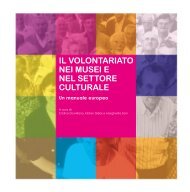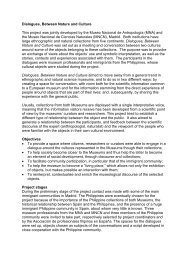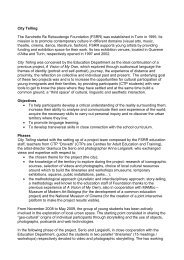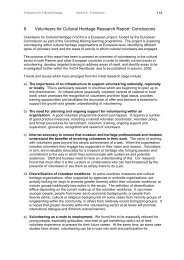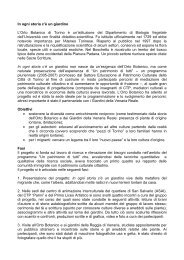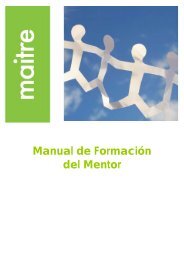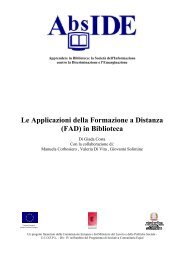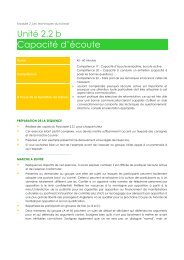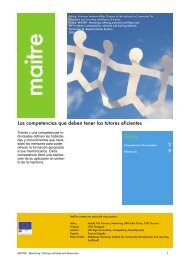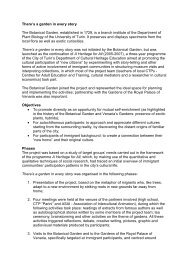Museums as places for intercultural dialogue - Network of European ...
Museums as places for intercultural dialogue - Network of European ...
Museums as places for intercultural dialogue - Network of European ...
Create successful ePaper yourself
Turn your PDF publications into a flip-book with our unique Google optimized e-Paper software.
a given heritage which, until that moment, they were precluded fromsharing or understanding.Table 1 – Outputs, outcomes, impact <strong>of</strong> the pilot projectsThis process, by and large a one-way, linear trajectory, clearly emergesfrom objectives set <strong>for</strong> the pilot projects such <strong>as</strong>: to ‘hand over thebaton <strong>of</strong> local history;’ to ‘help new citizens see themselves reflectedin the evidence <strong>of</strong> the local p<strong>as</strong>t;’ to ‘rethink our model <strong>of</strong> knowledgetransmission to an adult audience which is new to these issues.’However, if we accept the definition <strong>of</strong> <strong>intercultural</strong> <strong>dialogue</strong> put <strong>for</strong>wardin the previous chapter – a process (not a goal) actively engaging bothautochthonous individuals and those with an immigrant background,which is trans<strong>for</strong>mative on both sides, and in which all are equalparticipants; fostering reciprocity between the museum and its diverseaudiences, by bringing into <strong>dialogue</strong> their different perspectives,experiences and knowledge b<strong>as</strong>es – it becomes clear that there isyet another, demanding political choice museums have to make: thechoice <strong>of</strong> cultural inclusion. 9 In this model, the emph<strong>as</strong>is is placed onthe genuine engagement <strong>of</strong> individuals not only <strong>as</strong> audiences, ‘butalso <strong>as</strong> creators, producers, distributors, commentators and decisionmakers’10 taking an active part in the choices <strong>of</strong> the institution <strong>as</strong> well<strong>as</strong> in the negotiation and creation <strong>of</strong> meaning.This can only be achieved if the museum is able to evolve into aninstitution which is less self-referential, more rooted in the life <strong>of</strong> thesurrounding community, and more open to exploring collaborativemodes <strong>of</strong> operation, sharing strategies and objectives, including newvoices, skills and narratives. Many <strong>of</strong> the projects described in thefollowing pages have taken the first steps in that direction.1Unless otherwise credited, all quotations in this chapter are from pilot project selfevaluation<strong>for</strong>ms.2See S. Bodo, “The challenge <strong>of</strong> creating ‘third spaces’: Guidelines <strong>for</strong> MAP <strong>for</strong> IDpilot projects.”3Migration, integration, <strong>intercultural</strong>ity, dynamic identity, second generations.4C. Lagerkvist, “Empowerment and anger. Learning how to share ownership <strong>of</strong>the museum,” in Museum & Society, July 2006, 4(2), pp. 52-68 (www.le.ac.uk/museumstudies/m&s/issue%2011/lagerkvist.pdf).5The involvement <strong>of</strong> “new” and “traditional” audiences in a genuine process<strong>of</strong> consultation and participatory planning is a principle only relatively recentlyacknowledged and endorsed in <strong>of</strong>ficial documents like the Code <strong>of</strong> Ethics <strong>of</strong>the International Council <strong>of</strong> <strong>Museums</strong>, which reads: ‘<strong>Museums</strong> work in closecollaboration with the communities from which their collections originate <strong>as</strong> well<strong>as</strong> those they serve.’ See ICOM Code <strong>of</strong> Ethics <strong>for</strong> <strong>Museums</strong>, 2006 (http://icom.museum/ethics.html#section6).6Dutch pilot projects in particular, clearly distinguishing themselves from other MAPprojects by their emph<strong>as</strong>is on the visualisation <strong>of</strong> <strong>intercultural</strong> dynamics throughcontemporary art languages, rather than on collections <strong>of</strong> objects, provide usefulinsights on the importance <strong>of</strong> focusing not only on the historical heritage, but alsoon ‘the future <strong>of</strong> multicultural heritage’ (see Evelyn Raat’s introduction).7Tongue to tongue. A collaborative exhibition (Centre <strong>for</strong> African Studies and Museum<strong>of</strong> Anthropology and Ethnography <strong>of</strong> the University <strong>of</strong> Turin)– i.e. the institutional,scientific, didactic language <strong>of</strong> the museum vs. the autobiographical, evocative,emotional language <strong>of</strong> mediators.8The model <strong>of</strong> access development, widely adopted throughout Europe in thepost-war period, is rooted in the idea <strong>of</strong> the “democratisation <strong>of</strong> culture.” Its goal isto improve access to a dominant culture which is held <strong>as</strong> universally valuable, byidentifying barriers and underrepresented groups, and developing programmes andactivities aimed at promoting their participation.9The model <strong>of</strong> cultural inclusion is closely connected with the notion <strong>of</strong> “culturaldemocracy,” <strong>of</strong>ficially endorsed in the concluding recommendations <strong>of</strong> theIntergovernmental Conference <strong>of</strong> the <strong>European</strong> Ministers <strong>of</strong> Culture promoted byUnesco in Helsinki, 1972.10F. Matar<strong>as</strong>so, Amid the affluent traffic: the importance <strong>of</strong> cultural inclusion, 2006(www.nesf.ie/dynamic/pdfs/i.%20Matar<strong>as</strong>so.pdf).Activities• themed guided or selfguided tours• arts, storytelling or reminiscenceworkshops• exhibitions: virtual, collaborative andtravelling• autobiographical presentations,installations or displays• filmed conversations• “narrative routes”• “geo-emotional” maps• commission <strong>of</strong> artworks, <strong>of</strong> theatremonologues• theatre per<strong>for</strong>mances• videos, short films• blogs, web content• multimedia plat<strong>for</strong>ms• launch <strong>of</strong> an <strong>intercultural</strong> clothing line• training courses• conferences, seminars, study days …OutputsIndividual• creativity, self-expression and selfrepresentation• exploration <strong>of</strong> new ide<strong>as</strong>, values,<strong>as</strong>pirations• interest in the arts/heritage• cultural participation• development <strong>of</strong> art-related skills• development <strong>of</strong> relational, social,organisational competencies• development <strong>of</strong> linguistic, pr<strong>of</strong>essionalskills• use <strong>of</strong> pre-existing competencies andskills, <strong>of</strong>ten left unexpressed in “day-todaysurvival”• starting point <strong>for</strong> further learning/training• self-confidence, motivation, personalpride• sense <strong>of</strong> belonging• recovering and sharing p<strong>as</strong>t stories,emotions, experiences• curiosity, openness towards othercultural expressions• challenging stereotypes• reduced social isolation, trust in others,team work …OutcomesSocial impact (community)• self-determination• empowerment• participation in decision-making• development <strong>of</strong> community networks• tolerance, conflict resolution• intergenerational / <strong>intercultural</strong>exchange• collective identity / sense <strong>of</strong> belonging• active safeguarding <strong>of</strong> local heritage• social cohesion …Institutional impact• growing attention to the needs andexpectations <strong>of</strong> “new citizens”• new competencies <strong>of</strong> staff• new communication / mediationstrategies• inclusion <strong>of</strong> new voices indocumentation, interpretation, display• diversified programming and work<strong>for</strong>ce• new partnerships, overcoming a selfreferentialattitude• awareness <strong>of</strong> the social role <strong>of</strong> themuseum• commitment to future projects /development <strong>of</strong> action plans• new perspectives on collections• greater knowledge <strong>of</strong> local migrationpatterns and immigration / integrationpolicies• development <strong>of</strong> collections andmuseum documentation system(artworks, videos, short films, oralhistory recordings, multimediaplat<strong>for</strong>ms) …Impact30 31



